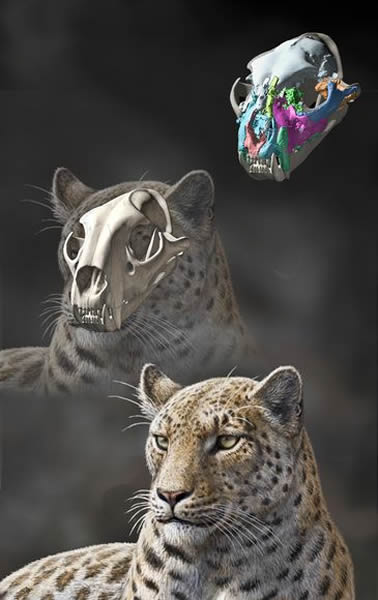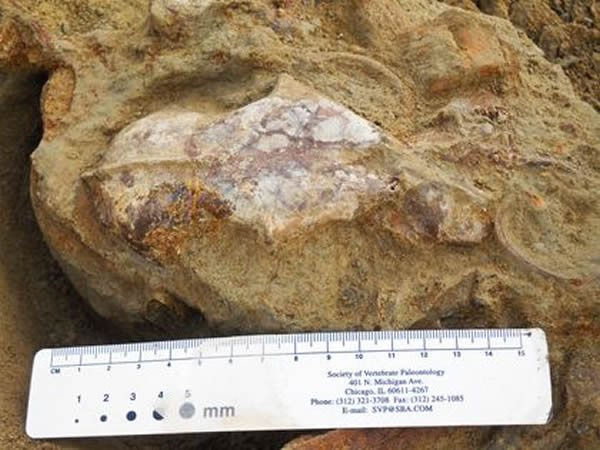Fossil Find Clears Up Big Cat Origins
Big cats may have originated in Asia as far back as six million years ago, as seen in this illustration of Panthera blytheae.
Anthropologists have long sought the answer to where and when big cats—mighty predators like lions, tigers, and leopards—slunk onto the earthly scene. Now, fossil finds on the Tibetan Plateau offer new evidence about the cats' earliest whereabouts.
Of all the felines, big cats were the first to split off into their own group from the common ancestor, so they are vital to understanding all cat evolution.
Previously, the oldest fossil evidence came from Africa and put the big cats at 3.8 million years old. But modern geographical patterns and molecular data—DNA comparisons of ancient fossils with modern bones—suggested Asian origins going back at least six million years.
Now scientists finally have the bones to back up that narrative.
The fossil discovery of a cat named Panthera blytheae, reported online today in the journal Proceedings of the Royal Society B, adds about two million years to the time when the animals branched out to become "big cats"—to the Late Miocene-Early Pliocene—and places the divergence squarely on the continent of Asia.
Heart-Pounding Moment
When paleobiologist Jack Tseng of the American Museum of Natural History in New York city and colleagues, including Xiaoming Wang and Juan Lui, went fossil seeking on August 7, 2010, they didn't expect to find something as significant as a big-cat skull. "It was a typical day of us driving around dirt trails in our SUVs and hiking in to scout out potential sites," Tseng recalls.
Often on such trips they'd come across scattered bone fragments from antelopes, horses, and rhinos. But this time something unusual was sticking up from the dirt.
"It was a partial lower jaw of a carnivore, and because of the preserved roots we could get a rough tooth count," says Tseng, a National Geographic Young Explorer grantee. "That plus the overall size told us it was from a fossil cat." (Cats tend to have fewer teeth than other carnivores, with more of them shaped and sized for shearing meat rather than crushing bones.)
As the team started digging, finding bits of fox, pica, and badger along with the usual hoofed mammals, they happily realized they were in a bone bed—where diverse species were well preserved in place, not just weathering on the surface.
And then came a heart-pounding moment.
The fossil of an ancient big cat is uncovered in the rock.
Photograph by Gary Takeuchi
"We uncovered the top of a skull, and I knew right away, from the width and the way the snout tapered off, it, too, was from a cat," Tseng says. While the lower jaw discovered earlier was exciting for the team, a skull, with its many bones and a structure that tends to remain fairly unchanged within a lineage, can guide scientists to an animal's spot on its family tree.
Unusual Carry-On
To reduce the risk of damaging the skull and other fossils, the team carved up the bone bed into smaller chunks, lifting out blocks of fossil-filled dirt.
Then they took the blocks back to Beijing, seven days by road, and onward by plane to Los Angeles. Tseng took the precious block housing the skull, wrapped in a custom-made plaster casing, as his carry-on bag.
In their Los Angeles lab, the scientists scraped away any doubt about what they had discovered. Comparing every bone in the skull and jaws to bones of today's cat species told them this was a sister to the modern snow leopard.
"I would have expected it to be closer to the common ancestor of all the living cat species," says Lars Werdelin, senior curator at Sweden’s renowned Natural History Museum (Naturhistoriska riksmuseet) and an expert on feline fossils, "but it is distinctly placed on the snow leopard line. This suggests a great stability in the adaptations of that species over millions of years."
"Fossils of big cats are rare at the best of times, and all are exciting. But this is especially so, as the fossils are so old and are unusually complete. Even a partial skull … can tell us a lot more about the animal than did the few bits and pieces of the earliest big cats found previously."
Himalayan Refuge
The fossil bed revealed something else intriguing. The mix of species discovered around the cat bones supports a connection, going back millions of years, between Tibet's big cats, Tibetan antelopes, and blue sheep—all part of a kind of environmental refuge on the top of the world.
"It appears the Plateau was a center of origin of a whole slew of animals that subsequently spread across Eurasia during the cold periods of the ice ages," says Werdelin. During that time the Plateau was always cold, he explains, "so animals that evolved there were preadapted to the climate of the ice ages, and this facilitated their spread."
The deep origins of the big cats and the location of diverse fossils supports a potentially lead role for the Tibetan Plateau—with its dramatic tectonic ups and downs—in the rise of some of today's dominant predators, big cats included.
Moreover, says Tseng, the fossils "told us there's a fluvial process involved, meaning bones were transported through a creek, river, or delta to accumulate in that spot." Such information helps in painting a clearer picture of the environment in which these animals evolved—and the processes that lead to such excellent bone preservation.
An Incomplete Puzzle
P. blytheae is a missing link of sorts: "These new fossils fill in a huge time gap and bring the fossil and molecular data in line," Tseng says.
But the fossil Tseng's team found, while currently the oldest of its kind, is not the final answer to the origin question. As a sister to the snow leopard, it can't be the oldest big-cat fossil out there.
So the discovery, and the fossil richness of the area, inspires the scientists to keep digging. "It points us to look for more ancestral big cats in the Miocene rocks of central Asia," Tseng says.
The scientists believe the timeline of big-cat evolution has more than historical significance.
The more that is known about the success of ancient big cats and their prey under varying environmental scenarios, says Tseng, the better equipped we are to predict how today's lions, tigers, and leopards will respond to change. Studying these origins "isn't just a sentimental thing," he says. "In some ways, it’s a survival thing."
Jennifer S. Holland
for National Geographic
Published November 12, 2013













